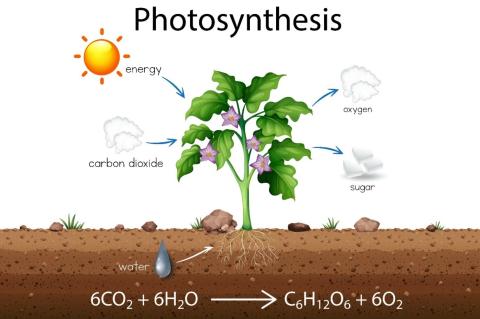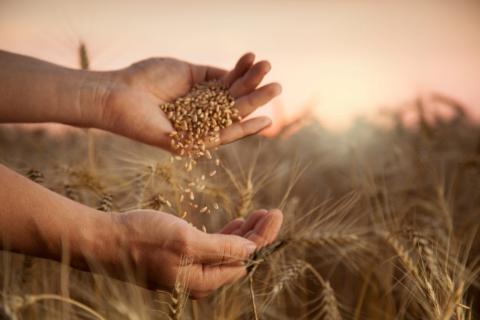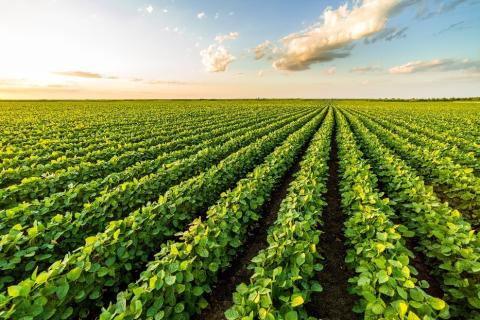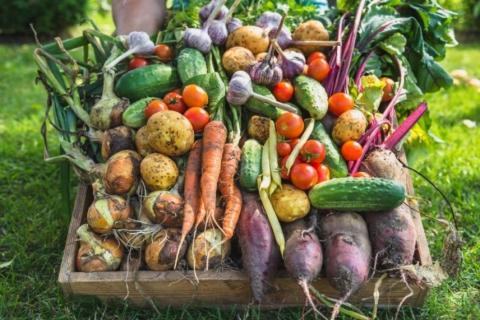2 August 2022
Louis Gray, University of the West of England & Dr William Stiles, Aberystwyth University.
Take home messages:
- Increasing levels of CO2 in the atmosphere are expected to change the nutritional composition of plants, and plant growth patterns
- Certain existing crops may start to perform less well, and other crops which are currently less widespread may become more suitable
- Understanding what crops will perform best under elevated CO2 scenarios is essential in order to maintain food security
Climate change is anticipated to have significant impacts on crop production systems from factors including changing weather patterns and increased pest and disease incidence. In addition to the factors surrounding climatic change, increasing atmospheric CO2 will also drive direct effects on plant growth potential and yield outcomes, and the nutritional composition of crop plant tissues. Developing an understanding of what influence this will have on crop growth patterns is essential in order to maintain food production and achieve food security.
The principal driver of climate change is the emission of greenhouses gases, chiefly carbon dioxide (CO2), as a consequence of human activities. The amount of CO2 in the atmosphere is now at the highest it has been in all human history, and almost certainly the highest it has been in the last million years (currently ~420 ppm). According to the Intergovernmental Panel on Climate Change (IPCC), CO2 levels could potentially rise to 670 ppm by 2100 and temperatures may rise by about 3-4 °C. This is expected to have substantial influence on agricultural production potential and on UK food security.
The increasing level of CO2 in the atmosphere is contributing significantly to changing weather patterns and other phenomena associated with climate change. Higher levels of atmospheric CO2 are also expected to alter plant growth patterns, as this gas is essential for photosynthesis. This may result in an increase in net primary productivity and therefore carbon capture, but it would also be expected to be complicated by a range of factors such as water and nutrient availabilities, heat stress, and others.
Changing plant growth patterns can also have significant impacts on the nutritional quality of cultivated crops, which may lead to shifting patterns of crop choice among producers, subject to consumer needs and demands, and shifting crop suitability, as the changing environment alters which crops will offer the greatest potential for yield and nutritional outcomes.
Wales and the UK are currently reliant on food imports to meet the population’s nutritional requirements. Considering the potential complications for food imports caused by Brexit and the environmental impacts associated with importing food, a shift in the type of crops the UK produces could be beneficial for the nutritional needs of the population.
Effects of increasing CO2
Plant responses to increasing atmospheric CO2 is a highly debated topic. A rise in CO2 is most often associated with increases in plant productivity due to higher rates of photosynthesis, but this is likely to be complicated by a range of factors including water and nutrient availabilities. Additionally, the different biological mechanisms employed for photosynthesis are also likely to have an effect.
There are three main types of photosynthesis: C3, C4, and CAM (crassulacean acid metabolism). The majority of food crops utilise either C3 or C4 photosynthesis (CAM is found in desert plants and is a strategy for minimising plant water loss), but the difference in biochemistry during photosynthesis between C3 and C4 crops may make certain plants better suited to high atmospheric CO2 conditions.
C3 is by far the dominant form of photosynthesis found in the plant kingdom, used by around 85% of plant species. This includes the essential cereal grains wheat, rice, barley and oats, as well as peanuts, spinach, soybeans, potato, tomato and many other crops. C4 is utilised in only around 3% of terrestrial plant species, but these plants include some other important food crops, such as maize, sugar cane, millet, sorghum, and cabbage.
To put things in simple terms, the difference between C3 and C4 photosynthesis centres on how plants use CO2 to make carbohydrates. During photosynthesis, an enzyme called RuBisCO is used to capture CO2, which is then converted into carbohydrates through plant biochemistry. In C3 photosynthesis, this process happens within the plant cell that the CO2 enters into, through the stomatal opening. In C4 photosynthesis, once CO2 enters the plant it is transported to a second cell via openings between cells called plasmodesmata. This is done to concentrate the CO2 where the RuBisCO is located, increasing process efficiency. The advantage this offers a plant is a reduction in photorespiration (which requires energy) and water loss, and better overall water-use efficiency.
Cereals:
Cereals are incredibly important crops, providing billions of tons of protein globally for human consumption and livestock feed. Elevated CO2 has been found to negatively impact the nutritional quality of grain crops. For example, studies on barley, rice and wheat, reported that elevated CO2 mediated a protein reduction of 15, 10 and 10%, respectively. However, this effect is not consistent across all cereal crops. When considering grain crops such as maize or corn, elevated CO2 does not appear to affect protein and micronutrient levels to the same degree. This difference in response is attributed to variations in the biological mechanisms employed by these plants when undertaking photosynthesis.
For C3 cereals, such as wheat, increasing CO2 levels have been reported to drive reductions in zinc, iron, nitrogen, and protein in grain tissue. The impact of elevated CO2 on nutrient concentration in grains has been shown to vary with soils and crops, with a greater negative effect on grains observed for fertile soil than infertile soil. Variability has also been noted between different genotypes and cultivars of the same crop, indicating some strains that may be better suited to high CO2 conditions.
For C4 cereals, such as maize, rising CO2 may not cause the reduction in protein concentration reported for C3 cereals, but these plants may also not benefit from the additional growth derived from the stimulation of photosynthesis. Given that C4 crops are able to concentrate CO2 internally, this means photosynthesis will be CO2-saturated even under normal CO2 conditions. Therefore, there will be no increase in the photosynthetic carbon assimilation and no increase in the rate of photosynthesis due to elevated CO2, resulting in very different responses in nutritional quality than C3 crops.
Although there seems to be little to no nutrient penalty associated with growing C4 plants under elevated CO2, current staple C4 crops might not be the best crops to tackle potential future malnutrition due to elevated CO2. This is because the nutritional quality of these C4 staples is generally not high due to poor protein digestibility rates, or low concentrations of compounds such as lysine. Indeed, a nutritional comparison of C3 and C4 grasses found that C3 grasses had higher protein content, but lower fibre content than C4 grasses when grown under elevated CO2. Thus, this could be considered to indicate that C3 food crops would still have a higher nutritional quality than C4 crops under elevated CO2 conditions.
Legumes:
Legumes are an agronomically important crop group due to their ability to fix atmospheric nitrogen (N). The incorporation of legumes in human diets can reduce the risk of a number of diet-related diseases such as obesity, diabetes, cardiovascular problems, and cancers that have increased over the last few decades. Variation in legume nutritional quality is also expected in response to elevated CO2 levels, but has been to shown to vary across different legume species.
In a study considering bean and soybean varieties, elevated CO2 did not affect the seed protein concentration of soybean, but increased seed protein concentration in beans. Lipid concentration was unaffected by elevated CO2 in both beans and soybeans. Soybean showed a significant reduction in manganese and potassium, and an increase in calcium at elevated CO2 when compared with ambient CO2 levels. Beans also showed a reduction in manganese and potassium, with an additional reduction in iron, and an increase in magnesium.
However, legumes appear to be less susceptible to changes in N concentration under elevated CO2, which contrasts with the 15% decrease observed in non-leguminous C3 species. This is due to factors including the decreased uptake of N from soil in non-leguminous plants, due to lower transpiration at elevated CO2. Legumes might also be better suited to limitations in N supply, as elevated CO2 can promote the rate of N fixation in nodule symbionts. In addition, increased C availability at elevated CO2 will improve N assimilation rates, in contrast to the impaired N assimilation associated with other non-leguminous C3 species. Nevertheless, the N fixation benefit from elevated CO2 observed in some legumes may be constrained by other environmental stresses, such as water availability.
An increase in legume production could be the solution to increasing environmental stresses and changes, as many appear to be quite resilient to predicted changes. Diversification of legume production and incorporation of new legume cultivars might also be beneficial. Cowpea, for example, a crop not commonly grown in Europe, not only has high protein quality, nutritional value and N-fixing ability, but is also more drought and heat resistant than many other legumes and other crops. Cowpea is also tolerant to low fertility soils and a range of soil pH, making it an interesting crop to consider alongside climate-change induced environmental instability.
Vegetables (root and leafy):
Elevated CO2 has been shown to increase the fructose, glucose and total soluble sugar content and to decrease protein, N, magnesium, iron, and zinc content of vegetables.
For root vegetable species, elevated CO2 was found to result in significantly higher yields, yet significant decreases in protein, vitamin C and fat content in carrot, radish and turnip. Additionally, all three of these vegetables showed an increase in sugar and fibre when exposed to higher levels of CO2. Elevated CO2 also decreased the amount of fatty acids, amino acids and a number of important minerals. Although these vegetables are currently high in nutrients, these findings suggest that future levels of elevated CO2 could in fact have a detrimental impact on the nutritional quality of root vegetables and alternative crops may need to be considered in future food systems.
The same may not be true for leafy vegetables. The nutritional value of spinach has been shown to increase under elevated CO2, with 14% higher vitamin C concentrations observed in spinach when compared with conventional conditions. This is likely to be highly variable across species and cultivars, and a wider study considering elevated CO2 effects on the nutritional quality of leafy vegetables, at a standardised 250-ppm increase, showed no overall effect. This was supported by meta-analysis focusing on iron, vitamin C and flavonoids, suggesting that elevated CO2 had no effect on these nutritional quality parameters. However, this meta-analysis did suggest that elevated CO2 increased antioxidant concentrations in leafy vegetables.
Fruit:
Fruits are also important sources of beneficial and essential nutrients for the UK population. A much larger proportion of fruit could potentially be grown within the UK than is currently, with some fruits likely to become more favourable as the climate changes. To understand the effects on fruit species, two commercially important species are considered here: strawberries and tomatoes.
For strawberry, elevated CO2 and higher temperature both caused significant increases in total polyphenol, flavonoid, anthocyanin and antioxidants in two strawberry varieties compared to plants grown under ambient conditions. The responses of strawberries were also significantly altered by the interaction of elevated CO2 and higher temperature, and all results were variable across strawberry varieties, suggesting some varieties are likely to offer better yield outcomes in these altered conditions. Interestingly, strawberry fruit grown under high CO2 (950 μmol mol−1) and high temperature (30 °C) was found to be rich in antioxidants and polyphenols, which could be beneficial in terms of human health.
For tomato, the evidence of effect is more variable. Elevated CO2 has been reported to lead to substantial reductions in protein, vitamin C, zinc and a range of other important nutrients and minerals. Contrastingly, studies have also shown increases in iron, copper, and certain nutritious compounds including ascorbic acid (vitamin C) under elevated CO2 when compared to ambient and open field conditions. As such it is challenging to conclude the effects of climate change on tomatoes grown in the UK, but the studies undertaken may at least indicate some potential benefits. Additionally, factors relating to the soil type, temperature and other environmental stresses would also be expected to influence overall effect.
Summary
Welsh agriculture currently faces significant challenges with regard to reducing the amount of greenhouse gases produced as a result of land management activities, whilst simultaneously finding ways to maintain food production in this changing climate.
The implications of elevated atmospheric CO2 on crop production and the nutritional quality of plants is complex. While some crops might respond negatively to future climatic conditions, others may benefit. This could depend on a number of factors such as their photosynthetic pathways. Many of the effects are likely to be contradictory depending on the crop plant, specific cultivar, and the environment that it grows within.
Due to the different biology and metabolic pathways of different crops, care must be taken when comparing the responses of different cultivars and crop families. It’s important to study the individual responses of crops to elevated CO2 and other environmental factors as well as compare similar groups in order to understand the complexity of the impact of environmental stresses on the nutritional quality of food systems. Nevertheless, understanding the effects of elevated CO2 on the crops on which we currently rely is essential in order to build a picture of how crop choices will need to change, and what crops should be targeted in the future, in order to meet the nation’s nutritional requirements and to maintain food security.
Louis Gray would like to acknowledge the kind support of the Sustainable Food Trust whilst undertaking this research.
If you would like a PDF version of the article, please contact heledd.george@menterabusnes.co.uk





